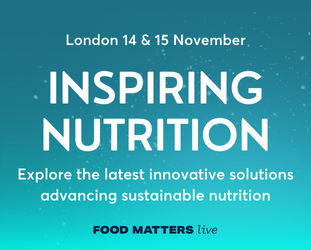Sports and active nutrition: the trends and products fuelling peak performance

Sports and active nutrition has been popular with professional athletes for some time – helping them consume the right foods and supplements to shorten recovery time, prevent injury and boost overall performance. Nowadays, the sector doesn’t solely target people playing sports for a living, but also the growing number of ‘weekend warriors’, moderate exercisers and amateur athletes looking for ways to maintain a healthy lifestyle and support their fitness goals.
The category has grown immensely post-pandemic, with more consumers recognising exercise and nutrition as a gateway to good health. Statistics shared by Lonza in a recent Food Matters Live webinar show the active nutrition space is currently a $23 billion market opportunity for innovation. In 2022, the global sports and active nutrition market size reached nearly $43 billion and is predicted to increase at a CAGR of 7.4% between now and 2030. The US has the largest market opportunity for sports and active nutrition products, according to Lonza, at $13.60 billion, whilst in the UK, sector product sales increased by 30.8%, and consumer spending reached £134 million between 2021-2022.
The importance of macronutrients for active living
The key macronutrients supporting exercise are carbohydrates, protein, and fat. Carbohydrates give the body the energy it needs to perform well during exercise, but it’s important to consume the right ones. Those with an active lifestyle and doing regular exercise should prioritise complex over simple carbs, such as wholegrains, fibrous fruits, vegetables, and legumes, rather than fizzy drinks, white bread, confectionary and cereals packed with sugar. Complex carbs are released more slowly in the body and provide it with enough energy for the entire workout period.
Consuming protein is essential no matter the type of exercise or dietary ambition an individual has, says Dr Juliette Strauss, Senior Lecturer in Exercise & Health Metabolism at Liverpool John Moores University and co-founder, Director, and Performance Nutritionist at Total Endurance Nutrition. Protein encourages the repairing of tissue and cells in the body after exercise. It can also keep us feeling fuller for longer, helping with weight management. The amount of protein someone needs depends on a person’s exercising habits, says Strauss, with athletes needing between 1.2-2.0g per kg of body weight daily and 0.8-1.2g per kg for the general population. For example, an athlete weighing around 70kg would need between 84-140g of protein a day, depending on their goals, while a moderate exerciser of the same weight would need 56-84g, according to what they want to achieve.
For the best effect, it’s recommended to consume complete proteins containing all the nine essential amino acids – histidine, isoleucine, leucine, lysine, methionine, phenylalanine, threonine, tryptophan, and valine. While animal products such as eggs, lean meat, and fish have all of these, plant-based protein is often incorrectly presumed to lack them. Products such as tofu, tempeh mycoprotein, edamame, quinoa, chia seeds, hemp, and buckwheat are all considered complete proteins. Saying this, not all sources contain the same amount. A 100g serving of buckwheat grain for instance will provide approximately 11g protein and 71g of carbohydrates, while the same amount of tempeh offers around 21g protein and 1.8g of carbs.
Combining incomplete proteins to form complete ones is another way to boost protein intake. For example, consuming legumes by themselves will provide large amounts of lysine, threonine, and tryptophan, but not enough methionine, but pairing them with wholegrain rice will provide methionine, making it a complete protein combination. Other foods like oatmeal, nuts like almonds or pistachios, and leafy greens like kale or spinach also contain protein that can contribute towards an individual’s daily intake.
Hydration is also key to replenish the body with the liquids it loses from sweating. Drinking water is recommended for activities lasting under an hour, while sports drinks are advised for more intensive training. These are packed with extra minerals including magnesium, sodium, potassium, and calcium, which can regulate the heartbeat, prevent cramping, and maintain joint and bone health. Many sports drinks also include carbohydrates like added sugars or sweeteners which give the body energy, and protein and electrolytes. Electrolytes regulate the level of water in the body and the nervous system, rebalance the pH level, rebuild damaged tissue, and move nutrients towards and waste out of your cells.
The amount of protein and carbs an individual needs however depends on how often they exercise and the intensity of the training. For instance, someone training for a marathon or completing high-intensity workouts will need more carbohydrates to provide the muscles and brain with enough energy for long periods. “The types of food and amounts of food required will vary depending on the type of sport and/or the goal of the exercise”, Strauss says.
Supplements: can they help?
Often, when people start a fitness plan, they take supplements to support their progress. There are several that can support an active lifestyle – from fish and algae oils, which improve flexibility and help individuals maintain strong joints, to magnesium, which boosts muscle performance and supports normal nerve function. Vitamins D, C, potassium, sodium, and zinc are also beneficial for supporting the immune system, reducing oxidative stress post-exercise, easing muscle cramps, and replenishing the body with essential minerals.
Energy and pre-workout products have become very popular, coming in the form of powders, gummies, and gels. These products contain a range of vitamins and minerals, with some also boasting caffeine and branched-chain amino acids, such as leucine, isoleucine, and valine, which help to build protein in the muscle and prevent fatigue. Some also contain L-citrulline which encourages nitric oxide production and relaxes the arteries to boost blood flow around the body. This non essential amino acid can also help with muscle soreness and fatigue.
Some supplements are essential particularly for vegan athletes and exercisers, says Jenaed Brodell, Founder and Lead Sports Performance Dietitian at Nutrition and Co. “Athletes requirements are higher than the general population for certain vitamins (vitamin D, b12, calcium, iron) and therefore careful planning is needed.” It is quite easy to source these vitamins in plant-based foods, she says, such as dairy-free products which tend to be fortified with all the necessary vitamins.
Protein supplements dominate the sports and active nutrition market. From powdered or gel forms of whey and vegan protein, to bars, yoghurts, puddings, drinks and fortified cereals, protein is probably one of the easiest to find, with plenty of options available. Despite protein intake being important, there is no need to rely on supplements. As Strauss explains: “Protein supplementation can be useful to support recovery as it helps the muscles to repair after strenuous exercise, however protein can also be consumed in the form of food. A protein supplement should only be used to help an individual consume enough protein or when the need for convenience dictates.” British Heart Foundation advice agrees with Strauss, stressing that protein supplements should not replace a balanced diet.
Another well-known supplement is creatine, which in 2020 was worth $262.2 million in annual sales in the US alone. The organic compound is produced naturally in small amounts in the kidney and liver, but it can also be found in red meat and fish, and is also available in supplement form. It is known to help the body push itself during high intensity workouts such as powerlifting, sprinting, football and swimming, by giving the muscles extra energy, shortening recovery time, and helping to build muscle mass. Demand for the supplement emerged following the 1992 Barcelona Olympic Games, when British athletes Linford Christie and Sally Gunnell said it helped them in their training and ultimately win gold.
Despite being a top selling product in the active nutrition market, a small number of studies in the past have suggested the supplement can damage the kidneys. Most recent research however argues such claims aren’t scientifically credible and that enough assessments have been carried out to prove creatine consumption is perfectly safe for healthy adults. This being said, moderate exercisers are not advised to take the supplement, says Strauss. “Supplements like creatine are fairly specialist and not needed by the general population” she explains.
For sports supplements to have an effect of course, individuals must exercise regularly and shouldn’t take them for any purpose besides improving physical performance and recovery. Strauss explains: “Sports nutrition products are safe for everyone to consume, however if they are not needed for a specific type of exercise or training goal, they would not be needed as part of a healthy diet, and some could in fact lead to consuming excess calories.”
The rise of carbohydrates
In the endurance sports market, a growing trend besides protein-based products is in carbohydrate-rich nutrition. “We have seen a growth in high carbohydrate products with upwards of 80g of carbohydrate per serving”, says Strauss. “This is becoming even more popular as professional endurance athletes report consuming (upwards of) 120g of carbohydrate per hour. Brands such as Maurten, OTE and Styrkr are leading the way with these products with Styrkr offering a drink mix with 90g of carbs per serving.”
The market for high-intensity training nutrition products could also see huge growth in the future, says Strauss. “CrossFit and Hyrox are growing in popularity. This may mean we see slight variations in formulations of products to include lactate buffering agents such as sodium bicarbonate.” Such a supplement is said to be able to decrease the acidity in working muscles to help the body engage in high intensity exercise for longer.
New trends
As the sports and active nutrition sector develops, it will also need to recognise its changing audience. There’s no question the demand for plant-based active nutrition products is growing. According to 2022 Glanbia insights, vegan claims grew nearly 40% in UK sports nutrition products launched between 2019 and 2020. They also made up close to one in five of new sport nutrition products by 2021. As Janaed explains: “With the push in more sustainable eating, plant-based diet’s popularity is increasing. The public just need to ensure they are educated enough to make informed choices on a plant-based diet ensuring [they get] enough protein and all the right nutrients.”
Another growing market is for older adults nutrition. Recent data from Mintel shows nearly 60% of sports and active nutrition users over 55 said they would be interested in more ‘age-inclusive’ products. Older athletes and regular exercisers require a higher level of protein in their diets, says Strauss. “The main requirements that change as we age is our protein need which increases to 1.2-1.5g/kg body mass. Again this can, and should where possible, be achieved through food rather than supplements as food will contain additional vitamins and minerals which a single source supplement will not.” Older adults engaging in regular or intensive exercise must also ensure they don’t lose muscle. Brodell explains: “This loss of muscle mass and strength is known as sarcopenia. It’s a major cause of weakness, fractures, and poor health among the elderly. Eating more protein could help your body maintain muscle mass combined with resistance training.” Adding in extra supplements alongside a healthy diet will also help, she adds, such as vitamin D, calcium, and vitamin B12.
As more people seek to boost their fitness level and improve their health, the sports and active nutrition sector will continue to remain an essential market to help individuals achieve their personal exercise goals. If it is to retain its high demand though, it must continue to adapt and become more inclusive for its changing audience.









